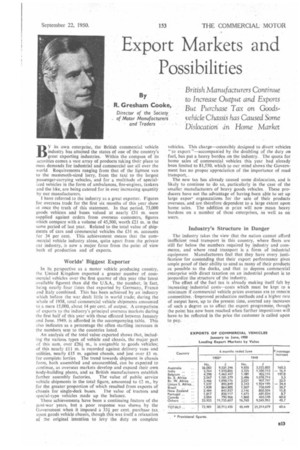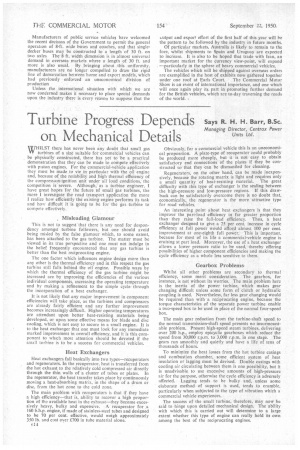Export Markets and Possibilities
Page 95

Page 96

If you've noticed an error in this article please click here to report it so we can fix it.
By R. Gresham Cooke,
Director of the Society of Motor Manufacturers and Traders
BY its own enterprise, the British commercial vehicle industry has attained the status of one of the country's great exporting industries. Within the compass of its activities comes a vast array of products taking their place to meet demands for industrial and commercial use all over the %%mid. Requirements ranging from that of the lightest van to the mammoth-sized lorry, from the taxi to the largest passenger-carrying vehicles, and for a multitude of specialized vehicles in the form of ambulances, fire-engines, tankers and the like, are being catered for in ever increasing quantity by our manufacturers.
I have referred to the industry as a great exporter. Figures for overseas trade for the first six months of this year show at once the truth of this statement. In that period, 73,000 goods vehicles and buses valued at nearly £31 m. were supplied against orders from overseas customers, figures which compare with a volume of 45,500, worth £21 m. in the same period of last year. Related to the total value of shipments of cars and commercial vehicles the £31 m. accounts for 34 per cent. This achievement means that the commercial vehicle industry alone, quite apart from the private car industry, is now a major force from the point of view both of production and of exports.
Worlds' Biggest Exporter In its perspective as a motor vehicle producing country, the United Kingdom exported a greater number of cornmercial vehicles over the first quarter of this year (the latest available figures) than did the U.S.A.' the number, in fact, being nearly. four times that exported by Germany, France and Italy combined. This has been achieved by an industry which before the war_ dealt little in world trade; during the whole of 1938, total commercial vehicle shipments amounted to a mere 15,000, about 14 per cent, of output. A comparison of exports to the industry's principal overseas markets during the first half of this year with those effected between January and June. 1949, is afforded in the accompanying table. This aka indicates as a percentage the often startling increases in the numbers sent to the countries listed.
An analysis of the total value exported shows that, includMg the various types of vehicle and chassis, the major part of this sum, over £26f m., is assignable to goods vehicles; of this nearly 411 m. is recorded against delivery vans and utilities, nearly £15 m. against chassis, and just over ET m. for complete lorries. The trend towards shipment in chassis form, both assembled and unassembled, can be expected to continue, as overseas markets develop and expand their own body-building plants, and as British manufacturers establish further assembly factories. The value of public service vehicle shipments in the total figure, amounted to £2 m., by far the 'treater proportion of which resulted from exports of chassis for single-deck buses. The value of tractors and special-type vehicles made up the balance.
These achievements have been a continuing feature of the post-war years, but a poor response was shown by the Government when it imposed a 33f per cent. purchase tax upon goods vehicle chassis, though this was itself a relaxation of the original intention to leVy the duty on complete vehicles_ This charge-ostensibly designed to divert vehicles " to export "-accompanied by the doubling of the duty on fuel, has put a heavy burden on the industry. The quota for home sales of commercial vehicles this year had already been limited to 81,550, which to our mind shows the Government has no proper appreciation of the importance of road transport..
The new tax has already caused some dislocation, and is likely to continue to do so, particularly in the case of the smaller manufacturers of heavy goods vehicles. These producers have not the advantage of having .been Ole to set up large expor organizations for the sale of their products overseas, and are therefore dependent to a large extent upon home sales. The addition in price will now mean heavy burdens on a number of these enterprises, as well as on users.
Industry's Structure in Danger The industry takes the view that the nation cannot afford inefficient road transport in this country, where fleets are still far below the numbers required by industry and commerce, and where road transport is a form of industrial equipment. Manufacturers feel that they have every justification for contending that their export performance gives ample proof of their ability to send as many of their products as possible to the docks, and that to depress comn-sercial enterprise with direct taxation on an industrial product is to jeopardize the structure of the industry.
The effect of the fuel tax is already making itself felt by increasing' industrial costs-costs which must be kept to a minimum if commercial vehicle prices overseas are to remain competitive. :Improved production methods and a higher rate of output have, up to the present time, averted any increases of such a degree as to affect the export programme, though the point has now been reached when further impositions will have,to be reflected in the price the customer is called upon to pay.
Manufacturers of public service vehicles have welcomed the recent decision of the Government to permit the general operation of 8-ft. wide buses and coaches, and that singledecker buses may be constructed to a length of 30 ft. on Iwo axles '[he 8 ft. width dimension is in almost universal demand in overseas markets where a length of 30 ft. and more is also usual. By bringing about this uniformity. manufacturers are no longer compelled to draw the rigid line of demarcation between home and export models, which had previously enforced an uneconomical division of production Unless the international situation with which we are now concerned makes it necessary to place special demands upon the industry there is every reason to suppose that the Laitput and export effort of the first half of this year will he the pattern to be followed by the industry in future months.
Of particular markets. Australia is likely to remain to the fore, whilst shipments to Spain and Uruguay are expected to increase. It is also to be hoped that trade with Iran, an important market for the currency view-point, will expand —particularly in the sphere of heavy commercial vehicles.
The vehicles which will be shipped against overseas orders are exemplified in the host of exhibits now gathered together under one roof at Earls Court. The Commercial Motor Show is an event of international importance, and one which will once again play its part in promoting further demand for the British vehicles, which are to-day traversing the roads of the world. t




































































































































































































































































